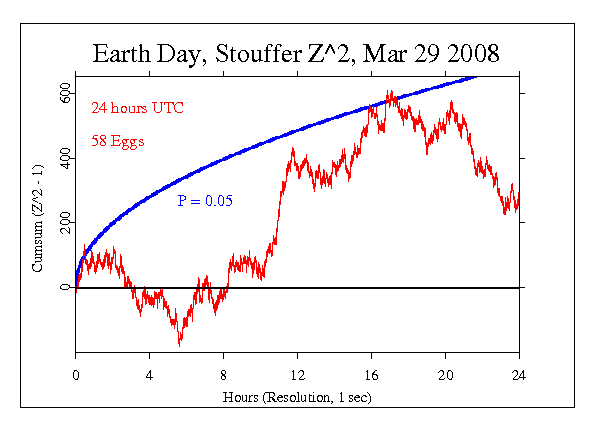|
Earth Day in 2008 is on April 22. This year it was on
Tuesday, and though it is more difficult for large numbers
to participate, there was a lot of publicity. I received
input from several sources working on recruiting people to
join together. I decided to make it a formal
hypothesis test again (previous formal tests in 2001 and
2006).
Incidentally, or perhaps not, the day also saw what many
consider to be a very important primary election in the US,
with Clinton and Obama fighting for Pennsylvania votes. This
was going on from about noon UTC, resolving about midnight
UTC.
Since
1970, Earth Day has been an annual event for people around the world to
celebrate the earth and our responsibility toward it. The Earthday
network says, "Volunteer. Go to a festival. Install solar panels on your
roof. Organize an event where you live. Change a habit. Help launch a
community garden. Communicate your priorities to your elected
representatives. The possibilities are endless! Do something nice for
the earth, have fun, meet new people, and make a difference."
Earth Day 2000 -- the 30th anniversary -- was expected to stir 500
million people on all continents and in more than 160 nations. Probably
the expectations in 2008 should also be high since the
environment is getting so much more play in the media, and a
continuously growing
recognition that we must pay attention to the earth's needs.
As before, consonant with GCP
purposes that include helping more people recognize that we can have a
better future by becoming more conscious of our interdependence, Earth
Day seems a natural event to examine. Since the Earth Day observances
are very diffuse, with no central, focal moment, we again
have decided that a
sensible prediction is to expect the whole day to show
the effects of large numbers of separate celebrations, rituals,
meetings, and consciousness raising events. The full 24 hours of data
for 22 April, 2008, based on UTC time, were extracted, and processed as
raw second-by-second composites across all eggs. At the time of
processing (on the 23rd), 58 eggs had reported. The figure below shows
the cumulative deviation for the 24 hour period. The total Chisquare was
86676 on 86400 degrees of freedom, for a p-value of 0.252
and Z = 0.66, positive but not significant.
Interestingly, a survey of all earthdays from 2000 to 2006
reveals that all have a modest positive deviation, and a
cumulative Z of 2.76.

|